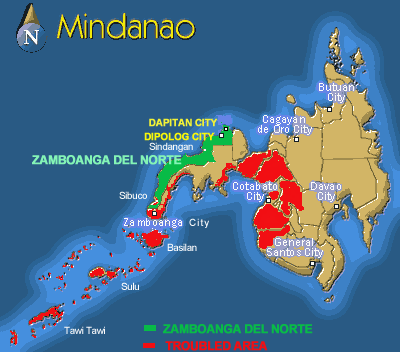Mindanao
MINDANAO, THE SECOND-largest island (36,537 square mi or 94,630 square km) in the Republic of the PHILIPPINES, is one of the three groups of over 7,100 islands in the country, the other two being LUZON and Visayas. The Mindanao group to the south consists of some 400 islands. The island Mindanao, about the size of INDIANA, occupies about a third of the Philippines's total area. Its highest point is on Mount Apo, which is 20 mi (32 km) to the west of Davao, often described as the world's largest city in terms of land area (943.5 square mi or 2,443.6 square km).
Mindanao lies in a zone of earthquakes and volcanic activity with an irregular, long winding coastline interspersed with numerous peninsulas, promontories, and bays some of which are very large and picturesque. As a tropical island, Mindanao has a mean annual temperature of 80 degrees F (27 degrees C) and a relative humidity of 77 percent. The rainy season stretches from May to November which is the summer monsoon, while the dry season lasts throughout December to April. Although much of Mindanao is sheltered by highlands, a typhoon is quite common during the peak rainy period (June to October). The average annual rainfall in the lowlands is about 80 in (203 cm).

Mindanao has a long history of political developments beginning with the arrival of Ferdinand MAGELLAN in 1521, which led to colonial rule in 1565. Spanish occupation lasted over three centuries until 1898, when SPAIN signed a treaty passing control of the Philippines to the UNITED STATES. Two years after Japanese occupation (1942–44), the Philippines gained independence but inherited two major security threats from the communist-led Huk rebels in the north of Luzon and the Moro secessionist rebels in southern Mindanao. The Philippine army finally defeated the Huk rebels in 1954, but the Moro insurgency continued into the 1970s when President Ferdinand Marcos declared martial law in 1972, lasting until 1981, in an attempt to destroy the Moro National Liberation Front (MNLF) led by Nur Misuari. With material support from LIBYA the MNLF was able to sustain military campaigns against government troops demanding independence for areas under predominantly Muslim population.
In 1996, the government under President Fidel Ramos initiated a dialogue that led to the signing of a peace agreement providing for self-rule for Muslims in the southern Philippines. While the agreement ended three decades of rebellion that claimed over 120,000 lives, minor skirmishes are still faced by government security forces from two other groups outside the MNLF: the Moro Islamic Liberation Front (MILF) and the Abu Sayyaf. The latter group became notorious after a number of kidnapping incidents involving both local and foreign victims, including the well-publicized kidnapping of 21 foreign tourists on the island of Sipadan on April 23, 2000, and another episode involving six workers on an eco-farm resort in Lahad Datu, Sabah, on October 5, 2003. The long years of political turmoil have left Mindanao, especially the four MNLF-controlled southern provinces, with widespread disruption to the infrastructure, public services and the economy, causing the average income of the local population in the region to drop to less than half of the national average.
Mindanao, by virtue of its location in close proximity to MALAYSIA, BRUNEI, and INDONESIA, has become a natural focus of a growth triangle involving economic cooperation initiatives between the four bordering countries under a multilateral cooperative scheme called Brunei-Indonesia-Malaysia-Philippines East ASEAN Growth Area (BIMP-EAGA). The September 11, 2001, terrorist attacks on the United States brought more condemnation of the MILF, which is alleged to have close links to al Qaeda, thus weakening both domestic and international support for the long-drawn struggle of the Muslim rebel groups. For the non-Muslims and the moderate Muslim nationalists, this may bode well for the future of the island, which can begin to lay arms and start concentrating with greater resolve on its neglected economic development programs based on the rich natural endowments of the region. Before the Marcos era, the region, with its fertile soils, abundant rainfall and sunshine, was one of the world's leading producers of several cash crops such as abaca (Manila hemp), sugar, and coconut. The region also produces banana, pineapple, coffee, pineapple, palm oil, and cotton for export, besides supplying the locally popular durian and flowers for the domestic market.